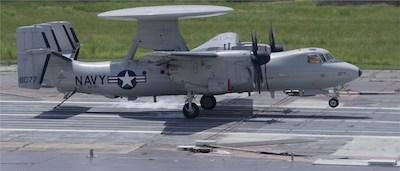Fri, Oct 12, 2018
Prerequisite For Carrier Operations Aboard The USS Gerald R. Ford
Advanced Arresting Gear (AAG) performance testing has been successfully completed for the C-2A Greyhound, E-2C+ Hawkeye, and E-2D Advanced Hawkeye aircraft by General Atomics Electromagnetic Systems (GA-EMS). The testing supports the Navy’s development of a propeller Aircraft Recovery Bulletin (ARB), which is a prerequisite for arresting propeller aircraft aboard USS Gerald R. Ford (CVN 78). The Navy completed the performance testing of the GA-EMS system on the Runway Arrested Landing Site (RALS) at Joint Base McGuire-Dix-Lakehurst in New Jersey.

“The AAG system is designed to arrest a broader range of aircraft and provide higher reliability and safety margins for the U.S. Navy’s Ford-class of aircraft carriers,” stated Rolf Ziesing, vice president of Programs at GA-EMS. “As each aircraft is brought in for testing, AAG continues to perform reliably, arrestment after arrestment. The successful turboprop arrestments at RALS mark another significant milestone that moves the Navy closer to initiating recovery testing for these aircraft aboard CVN 78.”
The AAG system has been exercised extensively, with more than 800 total roll-in and fly-in aircraft arrestments successfully performed at RALS. In addition, nearly double the approximately 400 planned at-sea F/A-18 E/F Super Hornet recoveries during sea trials and shakedown have been completed aboard CVN 78. GA-EMS continues to collaborate closely with NAVAIR and the shipbuilder to optimize the AAG system and the Electromagnetic Aircraft Launch System (EMALS), and support upgrades during the CVN 78 Post Shakedown Availability (PSA).
“We continue to stress the system, analyze results, and tune the system to ensure maximum performance,” stated Dean Key, senior director of EMALS/AAG programs at GA-EMS. “We are on target to be ready for fleet operations when CVN 78 completes its PSA in 2019. We are pleased with AAG’s performance, and remain focused on optimizing the system’s capabilities to meet the daily operations and mission requirements for CVN 78 and the next two Ford-class carriers currently under construction.”
AAG is a turbo-electric system designed for controlled deceleration of aircraft. AAG is installed aboard CVN 78 along with EMALS, which uses electromagnetic technology to launch aircraft from the deck of naval aircraft carriers. Both systems have been successfully tested during at-sea periods aboard CVN 78, and are currently in production for the future John F. Kennedy (CVN 79) and Enterprise (CVN 80) aircraft carriers.
(Image provided with General Atomics news release)
More News
Aero Linx: Model Aeronautical Association of Australia MAAA clubs are about fun flying, camaraderie and community. For over 75 years, the MAAA has been Australia’s largest fl>[...]
Touchdown Zone Lighting Two rows of transverse light bars located symmetrically about the runway centerline normally at 100 foot intervals. The basic system extends 3,000 feet alon>[...]
“Discovery and innovation are central to our mission at Virgin Galactic. We’re excited to build on our successful record of facilitating scientific experiments in subor>[...]
How To Get A Story On Aero-TV News/Feature Programming How do I submit a story idea or lead to Aero-TV? If you would like to submit a story idea or lead, please contact Jim Campbel>[...]
Student Pilot Reported That During Rotation, “All Of A Sudden The Back Of The Plane Kicked To The Right..." Analysis: The student pilot reported that during rotation, “>[...]
 ANN's Daily Aero-Linx (05.02.24)
ANN's Daily Aero-Linx (05.02.24) ANN's Daily Aero-Term (05.02.24): Touchdown Zone Lighting
ANN's Daily Aero-Term (05.02.24): Touchdown Zone Lighting Aero-News: Quote of the Day (05.02.24)
Aero-News: Quote of the Day (05.02.24) ANN FAQ: Contributing To Aero-TV
ANN FAQ: Contributing To Aero-TV NTSB Final Report: Cirrus Design Corp SR20
NTSB Final Report: Cirrus Design Corp SR20



